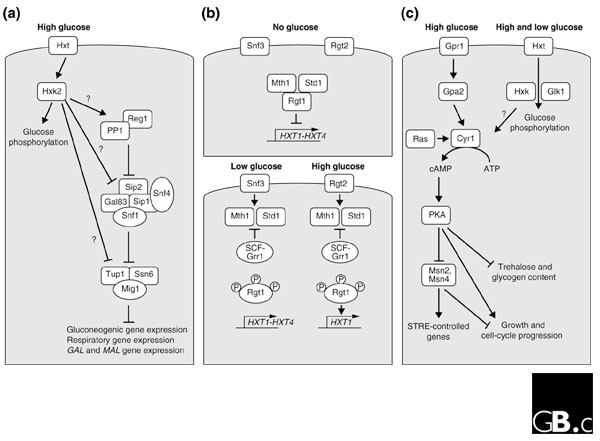Figure 1.

A simplified schematic representation of the three well-characterized glucose-response pathways in S. cerevisiae. (a) The main glucose repression pathway. In response to high glucose concentrations, the complex containing the Snf1 kinase inhibits the Mig1 repressor-containing complex and thus represses genes involved in respiration, gluconeogenesis and the metabolism of alternative carbon sources, such as galactose (GAL genes) and maltose (MAL genes). Protein phosphatase type 1 (PP1) acts in a complex with Reg1 to down-regulate Snf1 in low-glucose conditions. Glucose phosphorylation by Hxk2 is required for this pathway, but the step at which it acts is not known. (b) The Snf3/Rgt2 glucose-sensing pathway. In the absence of glucose, Rgt1 acts in a complex with Std1 and Mth1 as a transcriptional repressor of the HXT1-HXT4 genes. When glucose is present, the transcription factor Rgt1 is inactivated through SCF-Grr1-mediated inactivation and degradation of Mth1 and Std1, and hyperphosphorylation by an unknown kinase, resulting in dissociation of Rgt1 from the HXT promoters. Snf3 triggers the induction of HXT1-HXT4 in response to low glucose concentrations. High glucose concentrations further enhance HXT1 expression through Rgt2 in a process that involves conversion of Rgt1 into a transcriptional activator. (c) The Gpr1/Gpa2 glucose-sensing pathway. High glucose concentrations activate cAMP synthesis by the adenylate cyclase Cyr1 (which is dependent on Ras) through the Gpr1/Gpa2 G-protein-coupled receptor system in a glucose-phosphorylation-dependent manner. The resulting activation of protein kinase A (PKA) affects a wide variety of target genes involved in, for example, carbon metabolism and stress resistance. Some of these effects are mediated by the Msn2 and Msn4 transcription factors. STRE, stress-response element. See text for further details.
